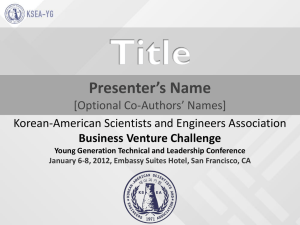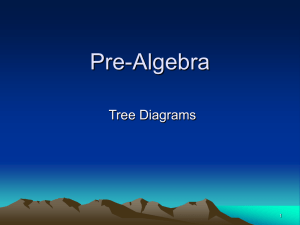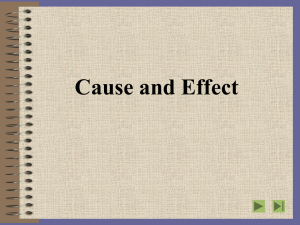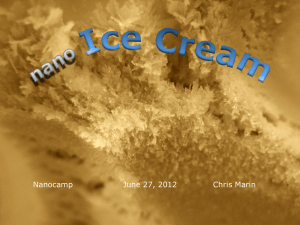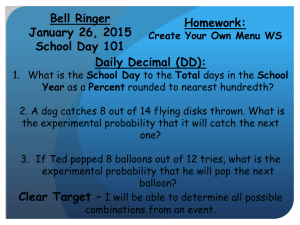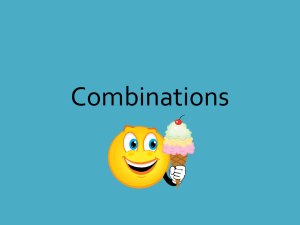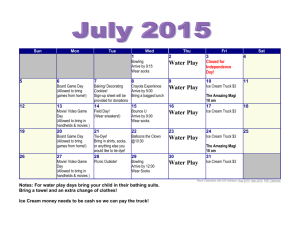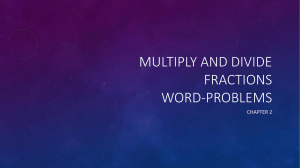Year 10: Draft lessons, term 1 (Word 2007, 27 KB)
advertisement
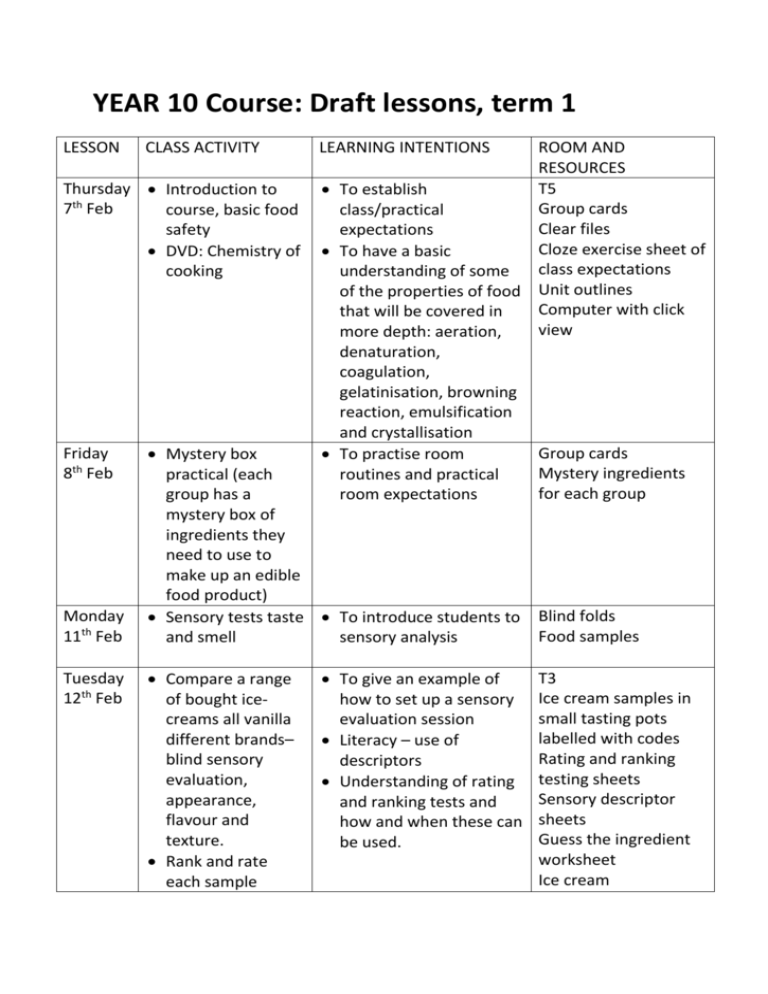
YEAR 10 Course: Draft lessons, term 1 LESSON CLASS ACTIVITY Thursday Introduction to 7th Feb course, basic food safety DVD: Chemistry of cooking Friday 8th Feb Monday 11th Feb Tuesday 12th Feb LEARNING INTENTIONS ROOM AND RESOURCES T5 To establish Group cards class/practical Clear files expectations Cloze exercise sheet of To have a basic class expectations understanding of some of the properties of food Unit outlines Computer with click that will be covered in view more depth: aeration, denaturation, coagulation, gelatinisation, browning reaction, emulsification and crystallisation Group cards To practise room Mystery ingredients routines and practical for each group room expectations Mystery box practical (each group has a mystery box of ingredients they need to use to make up an edible food product) Sensory tests taste To introduce students to and smell sensory analysis Blind folds Food samples Compare a range of bought icecreams all vanilla different brands– blind sensory evaluation, appearance, flavour and texture. Rank and rate each sample T3 Ice cream samples in small tasting pots labelled with codes Rating and ranking testing sheets Sensory descriptor sheets Guess the ingredient worksheet Ice cream To give an example of how to set up a sensory evaluation session Literacy – use of descriptors Understanding of rating and ranking tests and how and when these can be used. Guess the ingredients used in each sample. (prize for the student who guessed the most number of correct ingredients) Discussion on what is ice-cream Thursday Valentines Day 14th Feb Make chocolates: Melt chocolate and use to coat moulds and fill with a range of fillings such as biscuit crumbs, mint filling, and or nuts th 15 Feb Ice-cream – prior knowledge Students are put into groups of 3 to begin the ice-cream investigation. Introduction to the unit and what is expected. Each group to complete a power point presentation or a poster showing the results of their investigation. Each group presents these findings to the rest of the class at the end of the investigation Brainstorming on A3 identification and list of ingredients sheet Explore how chocolate behaves and discuss the properties of chocolate. Melt it in different ways – Bain Marie, microwave and a little directly in a pot. Different types of chocolate and equipment for melting chocolate different ways. Thermometers, chocolate moulds, fillings for chocolates, food colouring and paint brushes Group dynamics Expectations and the outcome for the investigation Finding out students prior knowledge T5 planning room paper in groups What is ice-cream? Why was it developed? Who developed it – what is its history? What ingredients is it made from? How is it made? How is it eaten? When is it eaten? Who eats it? What is its nutritional value? Put the brainstorms up around the room. Each group looks at all the displays and each group is given one of the questions to report back to the rest of the class on using all the posters. Dvd clip on ice cream 18th Feb How right were we? Making up vanilla ice cream Physical and functional attributes of each ingredient used to make a basic vanilla ice cream, custard based T3 Ice cream recipes, Ingredients Plastic containers for freezing Sticky labels Physical and functional attributes sheets 19th Feb History of icecream research session. Prepare a brief report to present to the rest of the class How to research effectively Citation and correct referencing Library LC1 Ice cream churning. Save a small amount of mixture to freeze without churning to compare with the churned icecream later. Meringue making to use up left-over egg whites and explore the properties of egg whites 25th Feb Ice-cream tasting Each group sets up a sensory evaluation for their ice cream and makes another batch 22nd Feb How to use an icecream maker – to find out how it works and to explore the properties of egg whites. How to label a product for freezing T3 Chilled ice cream mixes, ice cream makers, recipes , ingredients and equipment for making meringues Practice at setting up sensory evaluation Repeat making a custard base to get a better understanding of the functions of the ingredients being used Consistency with churning and properties of ingredients T3 Sensory evaluation sheets 26th Feb Churn the icecream made yesterday. Egg white experiments 28th Feb Complete history Group work of ice cream Research skills research (present findings to the rest of the class next Thursday) T3 Ice cream mixes Egg white experiment sheets T9 computer room Tasting studentmade vanilla icecream and meringues Physical and functional characteristics of your ice cream Introduction to star diagrams (each group produces a star diagram for their ideal ice-cream) More tasting! Flavoured ice creams Guess the ingredients Physical and functional attributes Tech products Food labelling T3 Star diagram sheet Sensory descriptor sheet Literacy skills more use of descriptors Thinking skills Looking at labels March 5th Making flavoured ice creams (each group making up a recipe of their choice chosen last week) How to follow a recipe and explore the properties of the ingredients used T3 Ice cream samples in small tasting pots labelled with codes Rating and ranking testing sheets Sensory descriptor sheets Guess the ingredient worksheet Ice cream identification and list of ingredients sheet. Photographs of the labels on the ice cream containers Trays set up for each group with the ingredients they need March 7th Evaluation of work so far Each group briefly presents their To share work so far Presentation and research skills 1st March 4th March T5 Group posters March 8th March 12th findings on the history of ice cream and an evaluation of the ice creams made. Which were preferred and why? What was the function of each ingredient used? Churning of flavoured ice creams More sensory analysis. Students choose an appropriate sensory test to test the ice creams made and prepare the test sheet. Exploring ingredients Each group has a worksheet with tasks and questions Mix and match exercise Guess the ingredients Exploring ingredients 1. Looking at eggs Exploring ingredients 2. Cooking eggs How to set up a sensory evaluation and collect useful information T3 Literacy for tech products Using the senses and prior knowledge to guess ingredients (the ingredients were all found in bought chocolate or vanilla ice cream. Students had previously looked at the labels on the ice cream containers) Applying knowledge learnt and reinforcing the terms used for tech products (Levels 3 and 4 of the NZC Tech Products) T3 Work sheets Mix and match tech product terminology sheets Ingredients on saucers for blind tasting. Label the top and bottom of the saucer with the code. Cocoa, cocoa liquor, milk powder, glucose, sucrose, salt, vanilla flavouring, sunflower oil, sweetener, milk, cream. Eggs (2 eggs per group) thermometer (one per group) March 14th March 15th March 18th March 19th March 21st March 22nd March 25th March 26th March 28th April 4th Relief Writing up setting agents Brandy snaps Churn ice cream and fill brandy snaps desserts Demonstrate making Easter eggs and hokey pokey Easter egg making Complete chocolates and Easter eggs. Wrap Introduction to setting agents. Each group has to set 500ml of water with any or a combination of the setting agents out on the trolley. Cornflour, Properties of ingredients. Examples of forming, manipulation and transformation T3 Easter egg moulds, chocolate moulds, paint brushes, chocolate, mix and match terminology exercise. Students complete this at the beginning of the lesson. Leave it on their table and use it to work our examples of each one. April 5th April 9th April 11 April 12 April 15th arrowroot, flour, gelatine, caster sugar, jelly crystals. Repeat of above lesson making changes based on what they found out Setting agents Swiss roll Exploring setting agents Exploring materials tech products test Modelling using a nutritional analysis programme. Cleaning the room T5 Revision of terminology and setting agents including uses and conditions required T5 C1 computer room April 16th April 18th Cleaning the room April Relief. 19th Going over the test and setting agents DVD. The unit could have a tech products and characteristics of tech focus where students develop their ideal ice cream using and gaining knowledge of the structure and composition of the ingredients and how they use this information to manipulate the ingredients they are using to come with their “ideal” product. Next step would be to develop a layered dessert for specified stakeholders for a particular occasion – tech practice focus but incorporating all the knowledge used.
